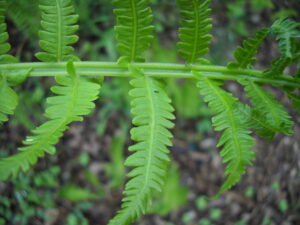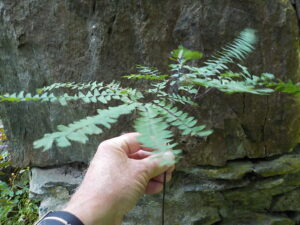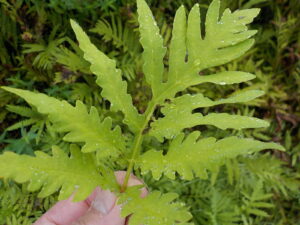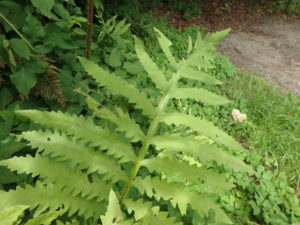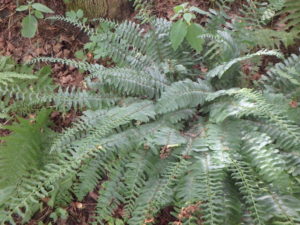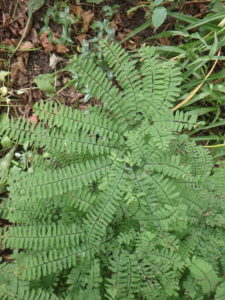Is It Time to Include Ferns in Your Garden?
One of my favorite ferns is the ostrich fern (Matteuccia struthiopteris). This is a big fern, with fronds up to five feet tall. Each fern tapers at both ends, and arrange themselves like the feathers of a badminton birdie. Its most distinguishing characteristic is a groove like you see in a stalk of celery, up the middle of each frond on the topside. It also produces fronds that turn brown and produce the spores. It is the fern that produces edible fiddleheads in the spring.
Another great fern is the maidenhair fern (Adiantum pedatum). In the spring it comes up on what look like black wires, then produces almost horizontal fronds that are fan-shaped. In the wild it indicates good rich soil. Books say it does well in moist, shady soil but I’ve had it for over 20 years in dry shade. I think once established it is fine in dry shade, but I’d water it for the first year if in dry shade, or in drought times.
Sensitive Fern (Onoclea sensibilis): This fern has light green leaves that are quite wide. Leaflet pairs are opposite each other (like a bow tie). Top-most leaflets are smooth, others have wavy edges. It is very frost-sensitive, hence the name. It often grows in big colonies, either in sun or shade. Can be a pest in the garden as it spreads by root. It is the only fern that I always pull out if it shows up in my garden as it spreads fast and is fairly coarse in looks.
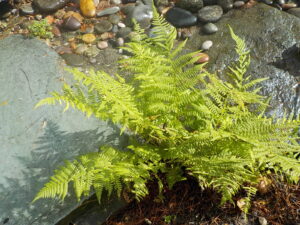
This hay-scented fern planted itself right by my front door, surrounded by stones in hot afternoon sun.
Another fern I like is the hay-scented fern (Dennstaedtia punctilobula). If you have crushed this fern and sniffed it, it smells something like fresh-cut hay. It is finely cut and stays just 1 to 3 feet tall. It is one of the few that will grow in a hot, sunny location such as a west-facing, sandy hillside, though it will grow in shade or rocky slopes. It spreads quickly, and will fill in an area, making a large colony. Sold in nurseries as a ground cover. It will out-compete weeds and grasses in sunny locations.
Learning How to Identify 8 Common Ferns
Ferns are under-rated and largely ignored by gardeners, but should not be. They can add much to a garden. I recently went to Walpole, NH where I met with Michael Nerrie of Distant Hill Gardens and Nature Trail. He introduced me to many ferns and also sold me a copy of a wonderful book, Identifying Ferns the Easy Way: A Pocket Guide to Common Ferns of the Northeast by Lynn Levine. It’s published by Heartwood Press.
Unlike other books I have seen that identify ferns, this one doesn’t require you to learn a whole new vocabulary. And the illustrations and layout make learning ferns easy. There are just 28 common ferns in the book, and there are silhouettes of each at the beginning of the book. The silhouettes are divided into 6 groups based on how the leaves are “cut”. So a quick look will identify most ferns, and the straightforward descriptions quickly confirm which fern you are looking at.
Imagine a frond of a fern that is all one big blade or leaf. Then imagine taking scissors and cutting that blade into leaflets. That is Group 1, once-cut ferns. Group 2 includes ferns that are twice-cut, and then divided into 2 groups based on how the fronds (stems) are arranged, either in a vase shape or in a random arrangement. And so on. There are five thrice-cut ferns, five ferns with 3 parts instead of one long blade, and one unique fern, the maidenhair fern which is unlike all the others. Pretty straightforward. Here are 8 common ferns you can easily learn to identify. Quotations below are from Ms Levine’s book.
Group 1: Once-cut
- Christmas fern (Polystichum acrostichoides). Unlike nearly all others, this fern stays green all winter, and has very dark green leaves. It grows in free-form clusters, and has simple leaves. The leaflets have “a little bump (ear) near the stalk” and are 1 to 3 feet long.
- Sensitive Fern (Onoclea sensibilis): Light green leaves. “Leaflet pairs are opposite each other (like a bow tie).” Topmost leaflets are smooth, others have wavy edges. It is very frost-sensitive, hence the name. Often grows in big colonies, either in sun or shade. Can be a pest in the garden as it spreads by root.
Group 2A: Twice-cut, Vase-like clusters
- Interrupted Fern (Osmunda claytoniana). A big fern with fronds up to 5 feet, this will grow in wet or dry shade. When spores are produced, they interrupt the arrangement of leaflets with smaller spore-producing leaflets that are not like the other leaflets. But not all plants will have an interrupted section, so look at a colony to find some that do (to confirm I.D.). The little leaflets that produce spores get dry and turn brown in mid-summer.
- Ostrich fern (Matteuccia struthiopteris). This is the fern that produces edible fiddleheads in early spring. It has a deep groove up the middle of the stem, like celery. Other ferns may have small grooves, but nothing like this. It is big: up to 5 to 7 feet tall, and shaped like a badminton birdy (vase-shaped). It is most common in moist shade, commonly along stream banks, but will grow in shady places in the garden. Can be very dramatic as an accent plant, but does spread.
Group 2-B: Twice-cut, Random placement of stems
- Silvery glade fern (Deparia achrostichoides): Frond is “very delicate for such a tall fern”. Can grow 2 to 3 feet tall. Lowest pair of leaflets point down. But for me, the identifying characteristics is that the spore cases of the leaflets are “arranged in a herringbone pattern on their undersides”.
Group 3: Thrice-cut
- Hay-scented fern (Dennstaedtia punctilobula). If you have crushed this fern and sniffed it, it smells like fresh-cut hay. It is finely cut and stays just 1 to 3 feet tall. It is one of the few that will grow in a hot, sunny location such as a west-facing, sandy hillside, though it will grow in partial shade or rocky slopes. It spreads, and will fill in an area, making a large colony. Sold in nurseries as a ground cover.
Group 4: Leafy parts in 3 distinct sections
- Bracken fern (Pteridium aquilinum). This grows in poor or barren soil in sun or shade. May form large colonies. Grows up to 3 feet tall. The blade (leafy part) is roughly horizontal to ground in 3 triangular leaflets, each with its own stem.
Group 5: Unique
- Maidenhair fern (Adiantum pedatum). This is often sold in garden centers as it is delicate-looking but sturdy and hardy on thin black stems that look like wires. In the wild it indicates good rich soil. The blade (the leafy part) is almost horizontal and is fan-shaped.
I found Lynn Levine’s guide easy to use – and it fits in the back pocket of my jeans. At $10.95, it’s a bargain. Distant Hill Gardens is full of wonderful plants to view and buy (including ferns), so pay them a visit. Open select weekends May to October, or by appointment (www.distanthill.org). Lynn Levine’s next fern workshop will be September 29 from 1 to 3:30 at Distant Hill Garden.
Henry can be reached at henry.homeyer@comcast.net.



